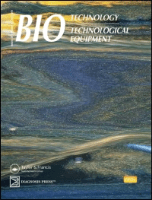
MOLECULAR BIOTECHNOLOGY
Scope & Guideline
Exploring the Frontiers of Molecular Innovation
Introduction
Aims and Scopes
- Molecular Therapeutics:
Research on the development of therapeutic strategies using molecular biology techniques, including gene therapy, monoclonal antibodies, and vaccine development. - Biotechnology in Agriculture:
Exploration of genetic engineering, plant biotechnology, and microbial applications to enhance crop yield, resistance to diseases, and sustainable agricultural practices. - Bioinformatics and Computational Biology:
Employing computational methods to analyze biological data, including genomics, proteomics, and systems biology, to identify biomarkers and therapeutic targets. - Environmental Biotechnology:
Application of biotechnological methods for environmental remediation, waste management, and sustainable practices, including the use of microorganisms and enzymes. - Cancer Biology and Therapy:
Investigation into the molecular mechanisms of cancer and the development of targeted therapies, including the role of non-coding RNAs and signaling pathways. - Nanobiotechnology:
Research on the use of nanomaterials and nanotechnology for drug delivery, biosensors, and imaging in biological systems.
Trending and Emerging
- CRISPR and Genome Editing Technologies:
The application of CRISPR technology in gene editing and its therapeutic implications is rapidly expanding, with numerous studies exploring its potential in various diseases and agricultural applications. - Non-coding RNAs in Disease Mechanisms:
Research on the roles of long non-coding RNAs (lncRNAs) and microRNAs in cancer progression, gene regulation, and therapeutic resistance is gaining prominence, highlighting their potential as biomarkers and therapeutic targets. - Synthetic Biology:
The integration of engineering principles into biology to design and construct new biological parts, devices, and systems is emerging as a significant trend, with applications in medicine, agriculture, and environmental science. - Personalized Medicine and Biomarker Discovery:
Increasing focus on the identification of biomarkers for personalized treatment strategies, particularly in cancer and chronic diseases, is becoming a major area of investigation. - Machine Learning and AI in Biotechnology:
The use of artificial intelligence and machine learning to analyze large biological datasets is trending, facilitating advancements in drug discovery, genomics, and predictive modeling.
Declining or Waning
- Traditional Agricultural Biotechnology:
Research in conventional methods of genetic improvement and plant breeding techniques has waned as interest shifts toward CRISPR and advanced genetic engineering methods. - Basic Molecular Biology Techniques:
There is a noticeable decline in publications focusing solely on fundamental molecular biology techniques, as researchers are increasingly integrating these techniques into broader biotechnological applications. - Microbial Bioprospecting:
Although still relevant, studies focused exclusively on the discovery of new microbial species for biotechnological applications are less frequent, with more emphasis on specific applications or gene editing.
Similar Journals

BMC BIOTECHNOLOGY
Catalyzing Progress in the Biotech CommunityBMC Biotechnology, a leading journal in the field of biotechnology, is published by BMC and has been a pivotal platform for open-access research since 2000. With a focus on the diverse areas of biotechnology, including biochemistry, genetics, and molecular biology, this journal holds a prestigious Q2 ranking in its category for 2023 and demonstrates a commendable percentile rank in the top 66th for its Scopus listings. Operating out of the United Kingdom and covering research from 2001 to 2024, BMC Biotechnology is committed to disseminating high-quality, rigorously peer-reviewed articles that foster advancements and innovations in the biotechnology landscape. Researchers, professionals, and students alike will benefit from the journal's rich content and dedicated commitment to enhancing scientific discourse within the realm of biotechnology.

BIOTECHNOLOGY & BIOTECHNOLOGICAL EQUIPMENT
Connecting Research and Real-World Applications in BiotechnologyBIOTECHNOLOGY & BIOTECHNOLOGICAL EQUIPMENT is a leading open access journal published by TAYLOR & FRANCIS LTD from the United Kingdom, dedicated to advancing the field of biotechnology since its inception in 1990. Committed to disseminating high-quality research, the journal has transitioned to open access since 2014, enhancing its accessibility for researchers, professionals, and students alike. With a notable impact in the field, it is categorized in the Q3 quartile for Biotechnology as of 2023 and ranks #193 out of 311 in the Scopus categories for Biochemistry, Genetics, and Molecular Biology. The journal aims to cover a diverse range of topics related to both biotechnological advancements and the equipment that supports them, thus fostering innovative research and practical applications in the biotechnology sector. With an evolving scope that reflects the dynamic nature of biological research, BIOTECHNOLOGY & BIOTECHNOLOGICAL EQUIPMENT plays a crucial role in bridging the gap between laboratory studies and real-world applications, making it an essential resource for anyone involved in biotechnology research.

APPLIED BIOCHEMISTRY AND BIOTECHNOLOGY
Transforming Ideas into Impactful ApplicationsApplied Biochemistry and Biotechnology is a leading journal published by Springer, dedicated to advancing research in the interdisciplinary fields of biochemistry, biotechnology, and applied microbiology. Established in 1981, this peer-reviewed journal covers a wide range of topics that encompass innovative techniques, methodologies, and applications of biochemistry and biotechnology in medicine, environmental engineering, and molecular biology. With a Q2 ranking in several categories and an increasing impact factor, the journal demonstrates significant influence and credibility within the scientific community. While traditionally subscription-based, the journal offers avenues for open access through selective agreements, making high-quality research accessible to a broader audience. Researchers, professionals, and students alike will find Applied Biochemistry and Biotechnology to be an invaluable resource for the latest developments and applications in biochemistry and its related fields, aiding in the quest for sustainable solutions and novel biotechnological advancements.

Biochemistry and Biophysics Reports
Unlocking the mysteries of biochemistry and biophysics.Biochemistry and Biophysics Reports, published by Elsevier, serves as a vital platform for the dissemination of innovative research in the fields of biochemistry, biophysics, cell biology, and molecular biology. With an Open Access model initiated in 2015, this journal aims to facilitate the unimpeded sharing of knowledge, allowing researchers, professionals, and students free access to significant findings and developments. The journal has established a presence in the academic community, currently holding a Q3 ranking in Biochemistry, Q2 in Biophysics, alongside its Q3 standings in both Cell Biology and Molecular Biology categories for 2023. These metrics underscore its commitment to quality and relevance, garnering attention with Scopus ranks reflecting its emerging influence. Located in the Netherlands, Biochemistry and Biophysics Reports continues to foster dialogue and collaboration among the scientific community through high-quality research outputs, contributing to advancements in understanding the intricate biochemical processes and biophysical principles that underpin life sciences.

Minerva Biotechnology and Biomolecular Research
Unlocking Potential: Bridging Science and Innovation in BiotechnologyMinerva Biotechnology and Biomolecular Research is an emerging journal published by EDIZIONI MINERVA MEDICA, dedicated to the fields of biotechnology, biomolecular research, and applied microbiology. With an ISSN of 2724-542X and an E-ISSN of 2724-5934, this journal aims to foster deeper understanding and innovative advancements in these rapidly evolving disciplines. The journal has been categorized in the Q4 quartile across four categories in the 2023 rankings, highlighting its nascent yet growing influence within the scientific community. Operating on an open-access model, it enhances accessibility and encourages the dissemination of knowledge to researchers, professionals, and students alike. Set in the heart of Italy, specifically at CORSO BRAMANTE 83-85 INT JOURNALS DEPT., 10126 TURIN, ITALY, Minerva Biotechnology and Biomolecular Research will continue to enrich the scientific literature from its inception in 2021 through 2024 and beyond, contributing to the global dialogue on biotechnological innovations and molecular research.

BioTech
Catalyzing Collaboration Across Scientific DisciplinesBioTech is a forward-thinking academic journal published by MDPI, specializing in the dynamic fields of applied microbiology, biotechnology, biochemistry, bioengineering, and biomedical engineering. Established for promoting impactful research from 2021 to 2024, this journal aims to bridge the gap between laboratory findings and practical applications, serving as a vital resource for researchers, practitioners, and students alike. With its Open Access model, BioTech ensures that groundbreaking innovations are freely available to the global community, fostering collaboration and knowledge transfer across disciplines. In the 2023 rankings, BioTech holds a strong position in Q2 and Q3 quartiles across various categories, reflecting its commitment to high-quality research output. Being indexed in renowned databases, the journal enhances its visibility and reach, making it a preferred platform for sharing transformative ideas and discoveries in biotechnology and related domains. Set against the backdrop of Switzerland’s thriving research environment, BioTech is poised to become an essential resource in the rapidly evolving landscape of life sciences.

BIOTECHNOLOGY AND APPLIED BIOCHEMISTRY
Fostering Collaboration in the World of Biosciences.BIOTECHNOLOGY AND APPLIED BIOCHEMISTRY, published by Wiley, is a renowned journal that bridges the gap between fundamental research and practical applications in the fields of biochemistry and biotechnology. With an ISSN of 0885-4513 and an E-ISSN of 1470-8744, this journal has been instrumental since its inception in 1986, focusing on diverse topics including applied microbiology, drug discovery, and process chemistry. The journal is currently recognized in various categories with impressive quartile rankings, showcasing its influence with placements in Q2 for applied microbiology, biotechnology, and biomedical engineering, among others. Researchers and professionals benefit from its comprehensive scope and critical insights into the latest advancements in these domains. Although not an open-access journal, it provides invaluable access options for academic institutions and professionals seeking to stay at the forefront of biotechnology innovations. Its commitment to presenting quality research facilitates the growth of knowledge and fosters collaborations across disciplines, making it an essential resource for anyone invested in the rapidly evolving landscape of biosciences.

BIOLOGICAL RESEARCH
Exploring the frontiers of life sciences.BIOLOGICAL RESEARCH is a prestigious, peer-reviewed journal published by the Société de Biologie de Chile, dedicated to advancing the fields of Agricultural and Biological Sciences, Biochemistry, Genetics, and Molecular Biology, and Medicine. With an impressive ranking in the top quartile (Q1) in these categories as of 2023, this journal maintains high academic standards and visibility, making it a vital resource for researchers and professionals alike. Operating under an Open Access model since 2013, it ensures that research findings are freely accessible to a global audience, promoting the dissemination of knowledge and collaboration across disciplines. With a publication history dating back to 1992 and continued updates until 2024, BIOLOGICAL RESEARCH serves as a crucial platform for innovative research that impacts both scientific and healthcare communities. The journal’s commitment to quality and relevance is evidenced by its competitive performance in Scopus rankings, further solidifying its role as a leading journal within the biological sciences.

IUBMB LIFE
Fostering Global Access to Cutting-Edge ResearchIUBMB LIFE is a prestigious, peer-reviewed journal published by WILEY, dedicated to advancing the fields of biochemistry, molecular biology, and cell biology. With an impressive impact factor and consistently ranked in the Q1 and Q2 categories across multiple relevant disciplines—including Biochemistry, Genetics, and Clinical Biochemistry—this journal has established itself as a leading platform for disseminating innovative research and critical reviews that propel scientific discovery. The journal spans a converged publication period from 1999 to 2024, providing comprehensive insights into the dynamic landscape of biochemical research. Researchers, professionals, and students alike are invited to explore its Open Access options, ensuring that groundbreaking studies are accessible to a global audience. As it continues to shape the future of life sciences, IUBMB LIFE remains a vital resource for those seeking to enrich their understanding and contribute to these rapidly evolving fields.

Journal of Genetic Engineering and Biotechnology
Shaping the Future of Biotechnology through GeneticsJournal of Genetic Engineering and Biotechnology, published by Elsevier Science Inc, is a prestigious open-access journal that stands at the forefront of research in the fields of biotechnology and genetics. Since its inception in 2011, the journal has provided a platform for cutting-edge studies that explore the complexities and innovations within genetic engineering and its applications in biotechnology. With a commendable Impact Factor and recognized as a Q2 journal in both biotechnology and genetics as per 2023 categorization, it ranks well within Scopus, evidencing its influence in the scientific community. Researchers and professionals accessing articles published in this journal benefit from timely contributions that bridge theoretical and practical aspects of genetic technologies. By fostering a collaborative environment, the Journal of Genetic Engineering and Biotechnology aims to promote advancements that drive science forward, making it an essential resource for students, academics, and industry practitioners alike. For those interested in making their mark in these rapidly evolving fields, this journal offers unparalleled access to high-quality, peer-reviewed research.